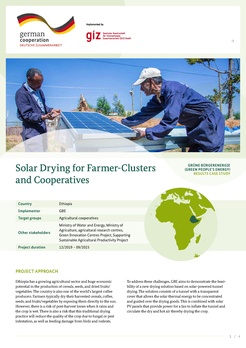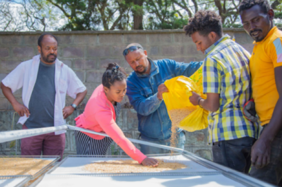Click here to register!
Difference between revisions of "Solar Drying for Farmer-Clusters and Cooperatives in Ethiopia"
***** (***** | *****) |
***** (***** | *****) m |
||
| Line 14: | Line 14: | ||
=='''Methodology of Data Collection'''== | =='''Methodology of Data Collection'''== | ||
| − | Data for this case study report was collected through a review of project documents, five qualitative interviews with representatives of the Ministry of Water and Energy, Ministry of Agriculture, representatives of GIZ Ethiopia, representatives of the beneficiary cooperatives and the agricultural research centres, and a quantitative survey of four representatives of the cooperatives. The case study was conducted between May 2023 and July 2023. At that time, some project activities were still ongoing. As a result, the impacts captured are not exhaustive | + | Data for this case study report was collected through a review of project documents, five qualitative interviews with representatives of the Ministry of Water and Energy, Ministry of Agriculture, representatives of GIZ Ethiopia, representatives of the beneficiary cooperatives and the agricultural research centres, and a quantitative survey of four representatives of the cooperatives. The case study was conducted between May 2023 and July 2023. At that time, some project activities were still ongoing. As a result, the impacts captured are not exhaustive. |
=='''Key Findings'''== | =='''Key Findings'''== | ||
Latest revision as of 12:53, 20 March 2024
Solar Drying for Farmer-Clusters and Cooperatives in Ethiopia
Project Approach
Ethiopia has a growing agricultural sector and huge economic potential in the production of cereals, seeds, and dried fruits/vegetables. The country is also one of the world’s largest coffee producers. Farmers typically dry their harvested cereals, coffee, seeds, and fruits/vegetables by exposing them directly to the sun. However, there is a risk of post-harvest losses when it rains and the crop is wet. There is also a risk that this traditional drying practice will reduce the quality of the crop due to fungal or pest infestation, as well as feeding damage from birds and rodents.To address these challenges, GBE aims to demonstrate the feasibility of a new drying solution based on solar-powered tunnel drying. The solution consists of a tunnel with a transparent cover that allows the solar thermal energy to be concentrated and guided over the drying goods. This is combined with solar PV panels that provide power for a fan to inflate the tunnel and circulate the dry and hot air thereby drying the crop.
Through this project, GBE aims to establish a scalable pilot and demonstrate solar drying projects in cooperation with the Green Innovation Centres for the Agriculture and Food Sector (GIC) and the Supporting Sustainable Agricultural Productivity (SSAP) Projects and their partner cooperatives. The geographical focus of the project covers two regions in Ethiopia: Oromia and Amhara.The GBE project finances the solar drying solutions and trains the members of the beneficiary cooperatives in the operation of the solar drying solution. Two different solar drying models have been considered: GrainPro® mobile solar tunnel dryer and the Innotech fixed solar tunnel dryer. In addition, two agricultural research centres are conducting studies to compare both models, with the aim of recommending the best one to consider for possible replication and upscaling.The beneficiary cooperatives contribute their labour to the installation of the drying solutions, as well as to the provision of and and the clearing of access roads for the transport of the solar dryer components and their installation. Furthermore, the project trains members of the beneficiary cooperatives and from the agricultural research centres in the operation of the solar drying solutions and in simple maintenance and servicing tasks.
Methodology of Data Collection
Data for this case study report was collected through a review of project documents, five qualitative interviews with representatives of the Ministry of Water and Energy, Ministry of Agriculture, representatives of GIZ Ethiopia, representatives of the beneficiary cooperatives and the agricultural research centres, and a quantitative survey of four representatives of the cooperatives. The case study was conducted between May 2023 and July 2023. At that time, some project activities were still ongoing. As a result, the impacts captured are not exhaustive.
Key Findings
Project Achievements
Solar-powered drying solutions have been installed on the premises of six cooperatives in the Amhara and Oromia regions. These cooperatives produce cereals as well as vegetables such as peppers and tomatoes. The solar dryers are owned and operated by the beneficiary cooperatives to dry grain and other agricultural products. According to representatives of the beneficiary cooperatives, their members can use the drying solutions free of charge, while non-members have to pay a fee. The fees collected are used by the cooperatives to pay for the maintenance and upkeep of the systems.
Drying solutions have also been installed at the agricultural research centres at Holeta and Kulumsa for demonstration, study and research purposes.A total of 30 solar dryers (26 in cooperatives and four at the agricultural research centres) have been put into operation, with daily drying capacities ranging from 200 kg to 1.000 kg.
Intermediate Impact
It was expected that due to the long rainy season in May – June 2023, members of the cooperatives would use the solar drying solution to dry their crops, thus avoiding harvest losses in terms of quantity and quality. However, no results on the experiences made could be captured through the quantitative survey or the interviews, since these were conducted before the use of the solar dryers during the rainy season. It was, however, noted, that all the cooperative representatives interviewed considered the new solar drying technology to be important for their cooperatives and that they expected a reduction in crop losses and a corresponding increase in income. It is also expected that during the off-season, the cooperative will be able to rent out the drying systems to farmers or farmer groups who have other crops to dry, such as fruit, beans, or chili peppers. This will generate additional income for the beneficiary cooperatives.
Climate Impacts
According to the calculation methodology of the United Nations Framework Convention on Climate Change (UNFCCC), the installations described above are estimated to save 5.7 t CO2 e/a in the year of installation by avoiding the use of fossil fuels. This is roughly equivalent to the annual CO2 emissions of four mediumsized cars in Germany.
Challenges in Project Implementation
The implementation of the project faced several challenges. First, there was the civil war in the northern regions of Ethiopia, which caused several delays in project implementation and prevented experts from travelling to these regions and meeting with members of the beneficiary cooperatives. Second, the COVID-19 pandemic also caused further delays in the implementation of the project. Due to these delays, the solar drying systems were installed only after the harvest season and could not be used immediately by the beneficiaries. This delayed the use and exploitation of the solar dryers after installation and opened discussions among the members of the beneficiary cooperatives on the proper use of the systems throughout the year, not just during the harvesting season.
In addition, it was difficult to find solar dryers on the market, and it took time to identify suppliers from abroad. As some of the solar dryers require significant capital, they are unaffordable for the beneficiaries without financial support. Furthermore, since the dryers are imported, they have to be paid for in foreign currency, which poses a further challenge to the beneficiaries. However, the agricultural research centres are conducting research and studies to explore the possibility of substituting some imported components with locally manufactured ones to support the local industry and reduce the costs at the same time.
Lessons Learned
Since solar dryers are only used for a few weeks a year, it is recommended to use the solar panels for other productive purposes during the rest of the year to increase the potential benefits and impact. The solar panels could be used, for instance, to power irrigation pumps or refrigerators. Moreover, using mobile solar dryers is more convenient, because they can be transported from one area to another and could be rented to other groups of farmers. Finally, these technologies would be more appropriate in the southern and central regions of the country, where it rains more frequently during the harvest season.
Sustainability of the Intervention
The project was designed taking into account measures to ensure the sustainability of the intervention results. Firstly, the project involved institutional partners in its implementation. The Ministry of Water and Energy is working with the agricultural projects, agricultural research centres and the beneficiary cooperatives to follow up on the intervention results and ensure that the solar dryer solutions are used appropriately. In addition, the Ministry is developing documentaries and media articles about this project to raise awareness of solar dryers for the agricultural sector and to attract the interest of potential users or partners who could help to ensure the sustainability of the project results. Secondly, the project has provided training to members of the cooperatives and the agricultural research centre on the operation and maintenance of the solar dryers, and users have received manuals. In addition, it is expected that service and maintenance contracts will be signed between the beneficiary cooperatives and solar- or agricultural engineering companies in Ethiopia. These will be used to carry out more complex maintenance and repair work after the one-year warranty provided by the system supplier has expired. Furthermore, the GBE project has also purchased tools and spare parts, which are stored at the premises of the beneficiary cooperatives and could be used for repairs.
Conclusion and Outlook
The project has successfully demonstrated the practicality and technical feasibility of using solar dryers to dry harvested agricultural products. While the current cost of the solar dryer solutions is not affordable for individual smallholder farmers, further incentives and support for agricultural- or solar-energy companies could pave the way for the development of a local ecosystem for the supply of solar dryer components. This could help to reduce costs, potentially making investments profitable in the future without the need for subsidies. Moreover, combining solar drying solutions with other PUE appliances to also use solar energy when drying is not required, could significantly improve the economics of solar drying systems. Furthermore, trainers and students at the agricultural research centres are using the solar dryers for training and demonstrating the technology to other smallholder farmers. They are also comparing the performance of the two solar dryer models tested with the aim of making specific recommendations on how to select the most appropriate solar dryer solution for the individual needs of users.The potential for up-scaling of the use of solar dryers is particularly high in Ethiopia’s large coffee and dried tomato sectors. Finally, the introduction of a new technology such as solar drying in Ethiopia can open up opportunities for the adoption of other new climate-friendly technologies for productive use in Ethiopia’s vast agricultural sector.























